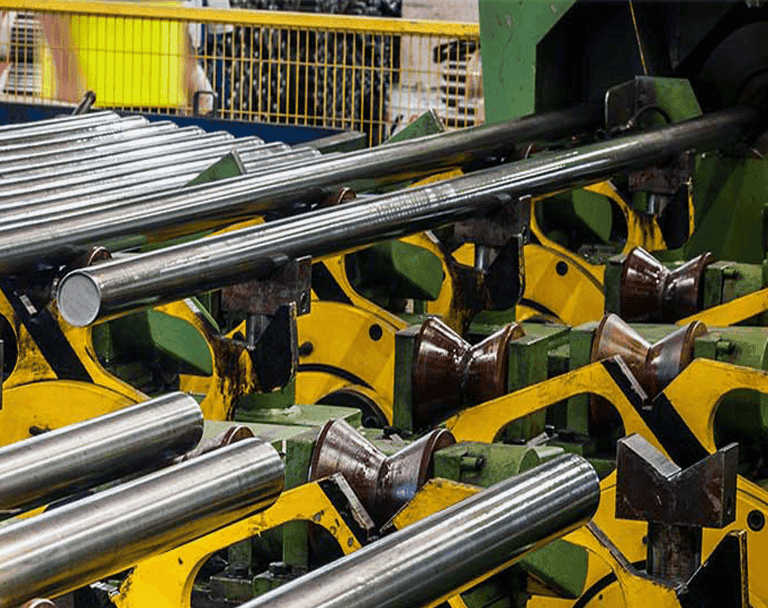It is the process of reprocessingcold drawn rolled steel bars. The purpose of cold drawing is to provide durability and to provide a flexible and smooth outer surface. Without heat treatment, the desired hardness can be achieved on the surface, but since the structure of the material is intervened, problems may occur in the surface part and internal structure of the material. As a first step, the surface cleaning process is applied to remove the unwanted scale layer on the surfaces of the hot rolled bars. This process, which was carried out using acid in previous times, is carried out in the current years by spraying high-pressure steel granules called sandblasting on the rod surface. The rods, whose surface is cleaned, are pulled through the molds of appropriate size. These molds are called "seals".
Cold Drawing Period
Cold finished bars hot rolled bars are drawn from a die. It is then produced by grinding method or peeling method. Depending on the application production methods, cold-completed steel bars are collected in four sections. These are;
- Cold Drawing Bars
- Peeled + Polished Bars
- Cold Drawn + Grinded + Polished Bars
- Peeled + Grinded + Polished Bars
Among these, cold drawing bars are the most common to use. The tensile and yield strengths and machinability of cold drawn, ground, polished bars are higher than cold drawn bars. In addition, the dimensional tolerances are in lesser ranges. Among the cold rolled steel bars, cold drawing bars are selected in terms of their mechanical properties. Compared to hot rolled bars, cold drawing bars have higher tensile and yield strengths. The reason for this is the phenomenon known as "hardening" or "hardening" caused by cold processing. Surface defects of cold rolled bars cannot be easily determined by visual methods. For this reason, if the surfaces of standard quality and ordinary quality cold rolled bars are desired to be free from surface defects, a certain amount of sawdust is taken from the surface.
Cold Drawing Lama Iron
Cold Drawing Lama iron is one of the most robust and durable irons on the market and has been produced recently. It is the main carrier and foundation stone of the sections where it is generally used, especially steel constructions. Areas of use are steel construction structures and automotive structures. One of the main purposes of this product is to strengthen the supports of the structures. Another purpose is to strengthen the bond between the two profiles or between the floor and the ceiling.
Cold Drawing Seamless Pipe
Cold drawing seamless pipes have more precise measurement tolerances than hot drawing seamless pipes. These are precision drawn pipes where the surface smoothness is less and the desired values are formed. In addition, these pipes are resistant to high pressure.
What is Rolling?
It is the plastic shaping process with the effect of rolling forces. Rolling is a very wide-use forming process that provides final product control and high production capacity. Rolling is divided into hot rolling and cold rolling.
Hot Rolling and Cold Rolling
It is the deformation process performed at temperatures above the recrystallization temperature where the ductility of hot rolling metals and alloys is high. Rolling of steels begins with hot rolling and, if necessary, is followed by cold rolling.
Soğuk haddeleme metal veya metal alaşımlarına yeniden kristalleşme sıcaklıklarından daha düşük sıcaklıklarda uygulanmakta olan plastik şekillendirme işlemine denmektedir.
Cold Completion Processes and Errors
Classically, hot rolling products are brought to their final dimensions by machining methods. At the same time, serious levels of surface smoothness are also ensured. However, labor and material costs also increase.
It is the plastic forming process applied to cold rolling metal or metal alloys at temperatures lower than the recrystallization temperatures.
- Scale purge
- Straightening bench
- Steel ball spraying machine
- Ultrasonic tester
- Surface crack tester
- Grinding stations
- Quality control and packaging system

Frequently Asked Questions?
Cold drawing is the process of reprocessing rolled steel bars.
- The surface cleaning process, which was previously carried out using acid, is carried out in the current years by spraying high-pressure steel granules called sandblasting on the rod surface.
- There are four sections in cold drawing time: cold drawn bars, peeled + polished bars, cold drawn + ground + polished bars, and peeled + ground + polished bars.
- Cold drawing bars are the most commonly used.
- Cold drawn bars have lesser dimensional tolerances than cold drawn, ground, polished bars and are selected for their mechanical properties.
- The tensile and yield strengths and machinability of cold drawn, ground, polished bars are higher than cold drawn bars.
| Section | Interval | Tolerans | Length |
|---|---|---|---|
| Rounded | 3,000mm ÷ 30,000mm | h9 | 2000mm ÷ 6000mm |
| Rounded | 31,000mm ÷ 75,000mm | h9 | 2000mm ÷ 6000mm |
| Altı Köşe | 4,000mm ÷ 7,000mm | h11 | 2000mm ÷ 4000mm |
| Altı Köşe | 8,000mm ÷ 65,000mm | h11 | 3000mm ÷ 6000mm |
| Square | 4,000mm ÷ 9,000mm | h11 | 3000mm ÷ 4000mm |
| Square | 10,000mm ÷ 60,000mm | h11 | 3000mm ÷ 6000mm |
